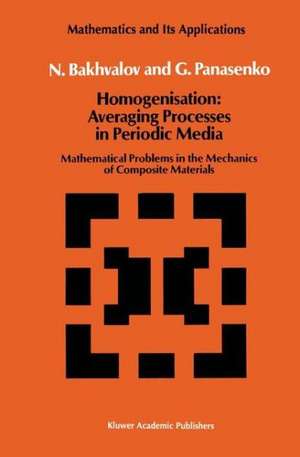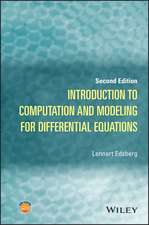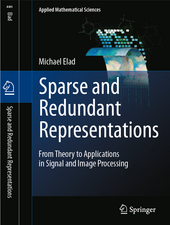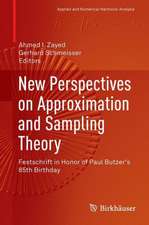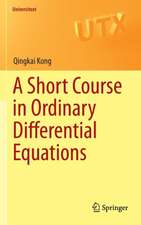Homogenisation: Averaging Processes in Periodic Media: Mathematical Problems in the Mechanics of Composite Materials: Mathematics and its Applications, cartea 36
Autor N.S. Bakhvalov, G. Panasenkoen Limba Engleză Hardback – 31 oct 1989
| Toate formatele și edițiile | Preț | Express |
|---|---|---|
| Paperback (1) | 645.79 lei 6-8 săpt. | |
| SPRINGER NETHERLANDS – 27 sep 2011 | 645.79 lei 6-8 săpt. | |
| Hardback (1) | 652.17 lei 6-8 săpt. | |
| SPRINGER NETHERLANDS – 31 oct 1989 | 652.17 lei 6-8 săpt. |
Din seria Mathematics and its Applications
- 15%
 Preț: 499.42 lei
Preț: 499.42 lei -
 Preț: 367.83 lei
Preț: 367.83 lei -
 Preț: 480.62 lei
Preț: 480.62 lei -
 Preț: 381.89 lei
Preț: 381.89 lei - 23%
 Preț: 321.52 lei
Preț: 321.52 lei -
 Preț: 435.39 lei
Preț: 435.39 lei - 20%
 Preț: 371.26 lei
Preț: 371.26 lei -
 Preț: 435.59 lei
Preț: 435.59 lei - 22%
 Preț: 333.11 lei
Preț: 333.11 lei - 15%
 Preț: 459.13 lei
Preț: 459.13 lei - 22%
 Preț: 321.53 lei
Preț: 321.53 lei - 18%
 Preț: 1055.51 lei
Preț: 1055.51 lei -
 Preț: 432.50 lei
Preț: 432.50 lei -
 Preț: 427.71 lei
Preț: 427.71 lei - 13%
 Preț: 351.91 lei
Preț: 351.91 lei -
 Preț: 356.64 lei
Preț: 356.64 lei - 15%
 Preț: 642.83 lei
Preț: 642.83 lei -
 Preț: 392.97 lei
Preț: 392.97 lei - 15%
 Preț: 651.67 lei
Preț: 651.67 lei - 15%
 Preț: 642.00 lei
Preț: 642.00 lei - 15%
 Preț: 647.59 lei
Preț: 647.59 lei -
 Preț: 389.49 lei
Preț: 389.49 lei -
 Preț: 394.12 lei
Preț: 394.12 lei - 15%
 Preț: 652.17 lei
Preț: 652.17 lei - 20%
 Preț: 651.57 lei
Preț: 651.57 lei - 15%
 Preț: 650.19 lei
Preț: 650.19 lei -
 Preț: 382.36 lei
Preț: 382.36 lei -
 Preț: 392.97 lei
Preț: 392.97 lei - 15%
 Preț: 657.39 lei
Preț: 657.39 lei - 15%
 Preț: 658.37 lei
Preț: 658.37 lei
Preț: 652.17 lei
Preț vechi: 767.26 lei
-15% Nou
Puncte Express: 978
Preț estimativ în valută:
124.81€ • 129.82$ • 103.04£
124.81€ • 129.82$ • 103.04£
Carte tipărită la comandă
Livrare economică 14-28 aprilie
Preluare comenzi: 021 569.72.76
Specificații
ISBN-13: 9780792300496
ISBN-10: 0792300491
Pagini: 366
Ilustrații: XXXVI, 366 p.
Dimensiuni: 156 x 234 x 24 mm
Greutate: 0.74 kg
Ediția:1989
Editura: SPRINGER NETHERLANDS
Colecția Springer
Seria Mathematics and its Applications
Locul publicării:Dordrecht, Netherlands
ISBN-10: 0792300491
Pagini: 366
Ilustrații: XXXVI, 366 p.
Dimensiuni: 156 x 234 x 24 mm
Greutate: 0.74 kg
Ediția:1989
Editura: SPRINGER NETHERLANDS
Colecția Springer
Seria Mathematics and its Applications
Locul publicării:Dordrecht, Netherlands
Public țintă
ResearchCuprins
1. Formulation of Elementary Boundary Value Problems.- §1. The Concept of the Classical Formulation of a Boundary Value Problem for Equations with Discontinuous Coefficients.- §2. The Concept of Generalized Solution.- §3. Generalized Formulations of Problems for the Basic Equations of Mathematical Physics.- 2. The Concept of Asymptotic Expansion. A Model Example to Illustrate the Averaging Method.- §1. Asymptotic expansion. A Formal Asymptotic Solution.- §2. Asymptotic Expansion of a Solution of the Equation u = 1 + ?u3.- §3. Asymptotic Expansion of a Solution of the Equation (K(x/?)u?)?= f(x) by the Averaging Method.- §4. Generalization of the Averaging Method in the Case of a Piecewise Smooth Coefficient.- §5. Averaging the System of Differential Equations.- 3. Averaging Processes in Layered Media.- §1. Problem of Small Longitudinal Vibrations of a Rod.- §2. Nonstationary Problem of Heat Conduction.- §3. Averaging Maxwell Equations.- §4. Averaging Equations of a Viscoelastic Medium.- §5. Media with Slowly Changing Geometric Characteristics.- §6. Heat Transfer Through a System of Screens.- §7. Averaging a Nonlinear Problem of the Elasticity Theory in an Inhomogeneous Rod.- §8. The System of Equations of Elasticity Theory in a Layered Medium.- §9. Considerations Permitting Reduction of Calculations in Constructing Averaged Equations.- §10. Nonstationary Nonlinear Problems.- §11. Averaging Equations with Rapidly Oscillating Nonperiodic Coefficients.- §12. Problems of Plasticity and Dynamics of Viscous Fluid as Described by Functions Depending on Fast Variables.- 4. Averaging Basic Equations of Mathematical Physics.- §1. Averaging Stationary Thermal Fields in a Composite.- §2. Asymptotic Expansion of Solution of the Stationary Heat ConductionProblem.- §3. Stationary Thermal Field in a Porous Medium.- §4. Averaging a Stationary System of Equations of Elasticity Theory in Composite and Porous Materials.- §5. Nonstationary Systems of Equations of Elasticity and Diffusion Theory.- §6. Averaging Nonstationary Nonlinear System of Equations of Elasticity Theory.- §7. Averaging Stokes and Navier-Stokes Equations. The Derivation of the Percolation Law for a Porous Medium (Darcy’s Law).- §8. Averaging in case of Short-Wave Propagation.- §9. Averaging the Transition Equation for a Periodic Medium.- §10. Eigenvalue Problems.- 5. General Formal Averaging Procedure.- §1. Averaging Nonlinear Equations.- §2. Averaged Equations of Infinite Order for a Linear Periodic Medium and for the Equation of Moment Theory.- §3. A Method of Describing Multi-Dimensional Periodic Media that does not Involve Separating Fast and Slow Variables.- 6. Properties of Effective Coefficients. Relationship Among Local and Averaged Characteristics of a Solution.- §1. Maintaining the Properties of Convexity and Symmetry of the Minimized Functional in Averaging.- §2. On the Principle of Equivalent Homogeneity.- §3. The Symmetry Properties of Effective Coefficients and Reduction of Periodic Problems to Boundary Value Problems.- §4. Agreement Between Theoretically Predicted Values of Effective Coefficients and Those Determined by an Ideal Experiment.- 7. Composite Materials Containing High-Modulus Reinforcement.- §1. The Stationary Field in a Layered Material.- §2. Composite Materials with Grains for Reinforcement.- §3. Dissipation of Waves in Layered Media.- §4. High-Modulus 3D Composite Materials.- §5. The Splitting Principle for the Averaged Operator for 3D High-Modulus Composites.- 8. Averaging of Processes in SkeletalStructures.- §1. An Example of Averaging a Problem on the Simplest Framework.- §2. A Geometric Model of a Framework.- §3. The Splitting Principle for the Averaged Operator for a Periodic Framework.- §4. The Splitting Principle for the Averaged Operator for Trusses and Thin-walled Structures.- §5. On Refining the Splitting Principle for the Averaged Operator.- §6 Asymptotic Expansion of a Solution of a Linear Equation in Partial Derivatives for a Rectangular Framework.- §7 Skeletal Structures with Random Properties.- 9. Mathematics of Boundary-Layer Theory in Composite Materials.- §1. Problem on the Contact of Two Layered Media.- §2. The Boundary Layer for an Elliptic Equation Defined on a Half-Plane.- §3. The Boundary Layer Near the Interface of Two Periodic Structures.- §4. Problem on the Contact of Two Media Divided by a Thin Interlayer.- §5. The Boundary Layer for the Nonstationary System of Equations of Elasticity Theory.- §6. On the Ultimate Strength of a Composite.- §7. Boundary Conditions of Other Types.- §8. On the Averaging of Fields in Layer Media with Layers of Composite Materials.- §9. The Time Boundary Layer for the Cauchy Parabolic Problem.- Supplement: Existence and Uniqueness Theorems for the Problem on a Cell.
